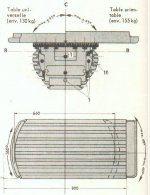Only the clamp down in between t slots, but who ever said advertising is accurate? ;-)
L7
Follow along with the video below to see how to install our site as a web app on your home screen.
Note: This feature may not be available in some browsers.
What's the problem with the FP2 beeing 1966 ?
If I we're you, I wouldn't hesitate to trim the corners of my table to enable the full rotation of the top plate !!!
Owning that table and enduring such a limitation would be sooooo frustrating !
Only the clamp down in between t slots, but who ever said advertising is accurate?
Hi Tien.Your table has the round ends and can turn all the way - on a FP3! The square table can not AFAIK. And the FP3 has a thicker "apron" (vertical table block) than the FP2 - more space in front of the column.
I was very close to snatching a Hermle universal table, but someone else wanted it.
...
I did not realize this. So to be sure I understand, the offset between the vertical ways and the front of the vertical table is larger on an FP3 than on an FP2? So a table which can 360 on the FP3 might interfere on the FP2?
...
I will not destroy a like-new FP3 table....
Only the clamp down in between t slots, but who ever said advertising is accurate?
155 mm (FP2) VS 173 mm (FP3) Bruce if I am not mistaken...
In fact, I'm not far from thinking that the best universal table would be the Hermle/Mikron....

Ouch, is the Hermle really 200 kg??
I read 150 kg for an FP2 somewhere - AFAIR.
A 2037 being just 113 kg, just makes me want one more...
You should ask member jdp993 what he thinks about it...
...
I would be interested in a reference for that. The manual for my FP2 does not give any weight limits in the specs, so I'd like to know what you found. I do have a memory of seeing a 150kg limit for the large horizontal table, which together with the table itself (50kg) suggests a mass limit of 200kg for the FP2 vertical table.
...
 )
)Notice
This website or its third-party tools process personal data (e.g. browsing data or IP addresses) and use cookies or other identifiers, which are necessary for its functioning and required to achieve the purposes illustrated in the cookie policy. To learn more, please refer to the cookie policy. In case of sale of your personal information, you may opt out by sending us an email via our Contact Us page. To find out more about the categories of personal information collected and the purposes for which such information will be used, please refer to our privacy policy. You accept the use of cookies or other identifiers by closing or dismissing this notice, by scrolling this page, by clicking a link or button or by continuing to browse otherwise.
